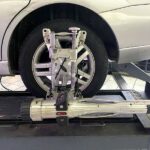Why Checking Your Tire Pressure is Important?
The first reason you should check the pressure in your tire is only for your safety reasons as well like:
- Your tire will last longer
- The handling of the vehicle is improved
- The control of the vehicle is improved
- The risk is decreased of blowouts and the accidents
- The economy of fuel gets better
- Decreases the carbon footprint
Why You Should Inflate Your Tire
- Betterment of Gas Mileage
Your car will waste more gas if it is running on non-inflated tires because it exerts extra force to move the car on the desired speed. When you are keeping them inflated, you can enjoy a safe and effective drive and fewer trips to the gas station. This way, you will be saving more money in your bank account.
- Preventing Wear And Tear
When you are driving your car with underinflated tires, it can make your tires wear and tear soon. Poor tire inflation forces certain parts of the tire to bear more weight. It can result in uneven damage. You might already know that tires are not that cheap, so you should avoid any type of damage and save your money.
- Reduce Toxic Emissions
Tires with low pressure can add more strain because they do not have more power to use. This can even result in a higher level of unfriendly emissions to the environment.
- Lower Risk Of Accident
Underinflated tires take a longer time to stop a car, which can cause serious and deadly accidents. When tires have low pressure, your car can slip on a wet road—moreover, the chances of blowout increase when you drive with an inflated tire.
After How Much Time You Should Check the Pressure of Your Tires
Many people are unsure about the right time to check the inflation in their vehicle’s tire. If you search on Google, you’ll find a variety of different answers. Some articles and integers will say that you should check your tires every second or third trip of the gas station and while others will ask you to check it after three to six months. Some tires and car manufacturing companies say that you should check the pressure of your tire every month, and others will say that after every second trip to the gas station will suffice.
Unfortunately, there is no one answer. Many factors can make you check the pressure of your tires. Some of these factors are:
- The weather. This means that if the weather is cold or hot, the pressure will decrease differently.
- The frequency and distance the vehicle is traveling
- Weight towed or carried
You should remember that every passing month, the PSI level decreases by one PSI. Furthermore, every 10° drop in temperature will lose an additional one pound of pressure from your tire.
Also, if your tire has a small puncture or the valve is leaking, your tire will losing air pressure more quickly. This is another reason you need to check the pressure of your tires consistently. As the pressure of the tire fluctuates constantly, you should check the tire once every month, and if the air pressure is lower than the recommended pressure, you should add more air.
Checking the Air Pressure
Look inside the glove compartment for the pressure gauge that your father gave you when you got 16 and check the tire pressure gauge. If you do not have any gauge in the glove compartment, you need to purchase one for yourself. If you only have a pencil style gauge, which is very cheap, the time is now to upgrade to a digital gauge. It is very easy to use, and you can buy it for under $11.
Now, let’s discuss how you can check the pressure of your tires. First, you need to wait for three hours after you have driven your car. Once three hours have passed, you should unscrew the cap of the valve stem and insert the end of the gauge. You need to press it inside. If you hear the hissing sound, you need to press even harder. Once the hissing sound stops, you can now check the reading. You can measure the pressure inside tires in PSI. In a pencil gauge, You’ll see plastic inside the gauge. When you push the end of the gauge inside the stem, the plastic will shoot out—the number where the plastic stops indicates your tire pressure.
Steps to Inflate Your Tire
Step 1
Park the car near the air pump of the gas station. The position of your car should be perfect so that you have enough space so you can walk among the pump and the car. The hose of the air pump should be long enough to reach all tires of your car easily.
Step 2
There is a trim tag available inside your car’s door jamb on the driver’s side door. On the trim tab, you will find the air pressure suggested by the manufacturer. If there is no information on the trim jamb, the glove box of your car, owner’s manual, or door of the gas tank may contain this information.
Step 3
Now you need to remove the valve cap of all of the tires and keep them in your pocket as you might lose the caps.
Step 4
Now, you need to check the air pressure of the tire, as mentioned above. This way, you will know how much PSI is already in the tire and how much more you need to add. If you add more pressure, this can cause imbalance, and the tires may burst.
Step 5
Inflate your tire till the recommended pressure. You should hold the air chuck of the pump firmly to the stem of the valve of your tire. Now, depress the pump’s lever, if you need to. Add some air to the tire and then remove the chuck to check the current air pressure. You need to use the air gauge again. Keep adding air and rechecking until you reach the recommended pressure.
Step 6
Now, lower the prong that is located inside the stem of the valve to release excess air if you need it. Most tires already include an exposed prong that helps to remove extra air. You can use your car key’s tip if your vehicle’s tire does not include one. Now, you should place back the caps of the valve back in each tire’s stem.
Tips You Should Know
You should purchase a pressure gauge for your tire so you can measure the exact pressure. These pressure gauges are not very expensive either. You can purchase a reliable gauge for as little as ten dollars. These devices are portable, and you can carry them along and measure the pressure whenever you want. The pressure of the tire is measured in PSI or pounds per square inch with this gauge.
Always compare the recommended pressure with the current PSI. If you are using the same tire that was fitted when you purchase the vehicle, then it is a simple procedure. For that, the PSI is mentioned in your car in the manual on the doorjamb displayed on a sticker. If you have replacement tires, the PSI is mentioned on the sidewalls.
When the weather is cold, you will be able to measure the pressure using a gauge and get accurate results. If the weather is hot or you just drove your car, the pressure gauge will show a higher reading. If you do not have a pump, you can visit the nearest gas station.
You should also check the spare tire in the trunk. If the pressure in your spare tire is low and you are stuck somewhere with a flat tire, you need a properly-inflated spare tire. If the spare tire has low pressure, you will not be able to reach the nearest gas station or repair shop.
Conclusion
Now, by following the above instructions, you can inflate your tires whenever you need them. It is recommended to keep an air gauge so that you can check the pressure of the air in your tire before leaving your home or your office. This way, you can also add air to your tires in time. Visit BudgetMotorsReno.com and Blog.BudgetMotorsReno.com







